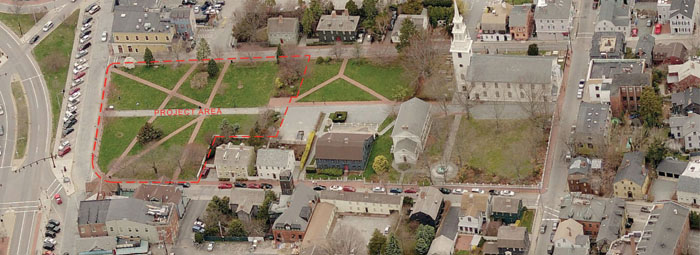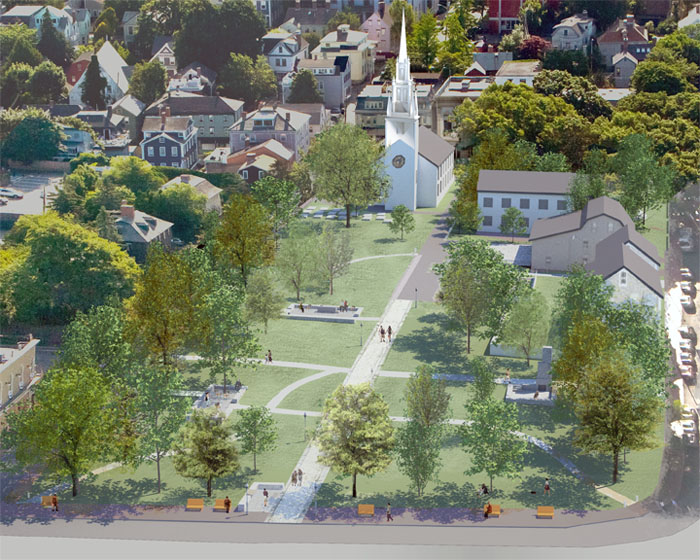Maya Lin: Breaking Ground in Newport
Known primarily for its over-the-top Gilded Age mansions, Newport, Rhode Island, is also home to one of the largest concentrations of colonial structures in the United States. A great champion of preservation of these eighteenth-century buildings, located mostly in the city’s dense core, was tobacco heiress Doris Duke, who owned one of the city’s great oceanfront estates.
In the 1970s, Duke took a particular interest in land abutting Trinity Church near the city’s harbor. Derelict buildings mixed with important historic structures, and Duke personally oversaw the moving of important buildings to the perimeter of the site and razing of ugly post-war buildings that included a furniture store and a dry cleaner. Replaced with spotty greenery of Ms. Duke’s own design, the land was named Queen Anne Square in honor of the British monarch’s gift of a bell to Trinity Church in the 1700s. Recently, this not-so-blessed plot became the subject of a nasty battle pitting the Newport Restoration Foundation, founded by Duke in 1968, against a vociferous group of local opponents of a planned redevelopment of the square.
Several years ago, aiming to build a monument to Duke’s memory, the foundation hired internationally acclaimed artist and architect Maya Lin to redesign the square, which at present is a green open space with little or no seating and only sparse outcroppings of trees and shrubs. Lin developed a scheme she calls “The Meeting Room,” which essentially proposes three stone seating areas, one with a fountain, and each containing quotes from Newport’s history etched into pavement stones. Lin chose the location of the seating areas based on foundations of buildings on the site in colonial times.

Even though the $3.5 million plan, to be paid for by the restoration foundation, was approved by the city council in December, the opposition (see citizensforqueenannesquarepark.org) will have nothing of it. They deride the seating areas as “kitty litter boxes” and dismiss Lin as a “celebrity architect” foisting a trendy design on a historic city. The restoration foundation counters that the entire approval process has been open and democratic and that opponents’ voices have not only been heard, but have informed iterations of the design.
“We asked for comments and changed some elements of the plan accordingly,” said Pieter N. Roos, executive director of the foundation, who is mocked on the opponents’ website as “The Salesman.” “We added more trees, seating, and usable green space,” continued Roos. “We did virtually everything they asked for. A lot of people tend to be fighting it just to fight it. The controversy gets pretty vile sometimes and it’s hard to stomach.”
Nationally, in a somewhat disinterested fashion, much support for the plan emerged. Locally, all of the usual suspects participated in supporting or deriding the planned park, depending on their orientation toward historical value. The foundation’s Roos takes pains to point out that his group felt a tribute to Duke should, for all of her historic preservation zeal, look to the future, not the past.
“The chairman of our board, Oatsie Charles, who was a good friend of Doris, believes that the present site isn’t what Doris intended,” he said. It was Charles, a member of the city’s old guard, who sought out Lin’s services, Roos added.
Lin, perhaps recognized most for her now beloved Vietnam Memorial in Washington, DC, created when she was still a student at Yale, is no stranger to controversy. She declined to be interviewed for this article, but looking at her drawings, models, and design statement, it is hard to imagine a more blameless and inoffensive design. Completed, the park becomes a civilized gathering space with sufficient seating and a verdant group of locally and regionally appropriate trees and shrubs, which nonetheless would preserve the view corridor toward Trinity Church. Its lighting is unobtrusive and will make the space usable for the community in the evening. The thresholds of the seating areas, framed in native stone and made to look dry laid instead of mortared, will contain words from the Royal Charter of 1663, which is the founding document of the State of Rhode Island and Providence Plantations, and specifically mentions religious liberty.
Far from being the radical, trendy and disruptive design described by the opposition, it is sensitive, contemplative, and appropriate to its surroundings. “Whenever you commission an artwork, you take a leap of faith about the outcome,” Roos said. “We trusted Maya and her vision is rewarding us.” While groundbreaking has not yet been set, pending approval of the project by the Rhode Island Department of Environmental Management, the restoration foundation is fully anticipating the project to be initiated in the coming year.

_______________________________________________________________________________________________________
James McCown is the architecture editor for Art New England.
